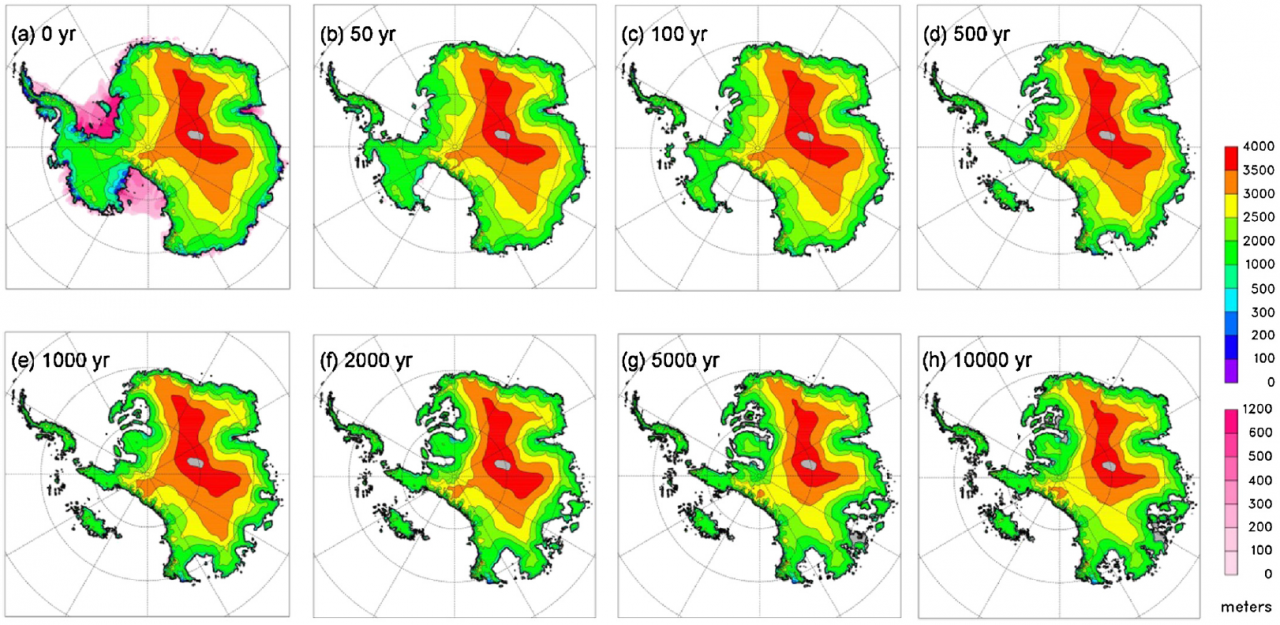by Scott K. Johnson, arstechnica, January 25, 2015
It has been a bit of a head scratcher. Records of sea level during the last few million years tell us that there have been some warm periods where sea level may have been as much as 20 meters higher than it is today. When fed the conditions that prevailed at the time, however, our computer models of ice sheets haven’t been able to reproduce such a swelling of the ocean.
The models can simulate that much sea level rise, but it requires temperatures much higher than were seen during those warm periods. Realistic losses of ice from Greenland and the fragile, western part of Antarctica (the West Antarctic Ice Sheet) could only provide something in the neighborhood of 3 to 10 meters of sea level rise. That leaves 10 to 17 meters for the East Antarctic Ice Sheet—the largest and most stable ice sheet—to chip in. Convincing the miserly East Antarctic Ice Sheet to be that generous with its contents isn’t easy, which is why the models required such high temperatures.
Updating the models
So what are the models missing? Penn State’s David Pollard and Richard Alley, and University of Massachussetts, Amherst’s Robert DeConto had an idea for something to try. Two things to try, really. They added a pair of physical processes to an ice sheet model that weren’t simulated previously. The first was hydrofracturing. When water reaches the ice sheet from rain or ice melt at the surface, it fills crevasses in the ice.
If they're filled to a great enough depth, the water pressure forces the crevasse to open even deeper—that's termed hydrofracturing. The other process results from the simple fact that a sheer cliff of ice can only be so tall before it collapses under its own weight—a condition not encountered in too many places today.
One place it does occur is where floating glaciers calve large icebergs. These occur on the coastal outlet glaciers at the edges of ice sheets that are the most vulnerable to warming. The glacier thins towards its outer edge, and at some point it grows thin enough that it begins to float. The point at which it floats off the bottom is called the “grounding line”—from there out to the end of the ice is called an ice shelf. Ice shelves that grind against the shore (think of it floating in a bay or fjord) act to hold back the flow of ice behind them. These shelves gradually melt from below as they float in their seawater bath. But they can also melt from above and shed large bergs of ice at their outer edge.
Both hydrofracturing and cliff failure can increase the shedding of icebergs from shelves, hastening their demise and uncorking the glacier behind them. Once these things are happening near the grounding line, though, they can really accelerate its retreat if it's in an unstable configuration where the ground surface drops as you head inland. (Significant portions of Antarctica match that description.) Once you start retreating in that situation, the glacier may have to retreat a long way to find a stable position again.
A hasty retreat
Having added representations of these two processes to the model, the researchers simulated a sudden change from modern conditions to warmer conditions like those past periods of very high sea level. Then they watched the virtual Antarctic glaciers respond.
The results were dramatic. The new processes combined to have a huge impact. Instead of about 2 meters of sea level rise, Antarctica lost enough ice to raise global sea level 17 meters over several thousand years. The fragile West Antarctic Ice Sheet collapses in a matter of decades, rather than centuries or millennia. There’s 5 meters of sea level rise in the first two centuries, after which retreat in portions of the East Antarctic Ice Sheet really get going.
Much more work will be required to make sure these new processes are being simulated accurately, but the early returns show it could put researchers in the ballpark of solving the puzzle of past high sea levels.
The relevance for our present situation is less direct, as the warming in the simulation was not realistic, but the possibility that West Antarctica could lose ice faster than we thought is a serious one. Richard Alley, whose work on this possibility we’ve covered before, explained to Ars via email, “I believe (and I suspect many people do) that it is important for us as scientists to provide not only the most-likely future outcome, but also the range of possibilities, including some sort of assessment of best-case and worst-case outcomes. Best-case is fairly easy, I believe, but worst-case is not; however, providing both is likely to be useful to many people.”
“The physical knowledge that too-tall cliffs fail is very old and familiar to every miner or quarry-worker. The physical knowledge that ice is not the strongest rock on the planet is also rather old. And, the suggestion that cliff failure could affect West Antarctic stability dates back to 1962,” Alley wrote. “We now have stronger evidence that sufficient West Antarctic retreat could lead to a higher calving front than any on Earth today, and higher than a stability limit suggested by recent papers. Putting that understanding into projections of the future, as in our new paper, has implications for the worst-case scenario. And, testing against the paleoclimatic record provides support for that understanding.”
He continued, “It is still too early to say that this is an accurate worst-case scenario. Step-application of the [warming] is too extreme, clearly… but, it is within the realm of possibility that for the time-scale of collapse, the true worst worst-case scenario could be even a bit faster than modeled here; the renewed interest in this topic is recent, and the number of scientific papers exploring the physics remains low.”
Earth and Planetary Science Letters, 2014. DOI: 10.1016/j.epsl.2014.12.035







No comments:
Post a Comment